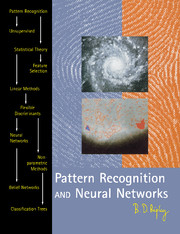Book contents
- Frontmatter
- Contents
- Preface
- Notation
- 1 Introduction and Examples
- 2 Statistical Decision Theory
- 3 Linear Discriminant Analysis
- 4 Flexible Discriminants
- 5 Feed-forward Neural Networks
- 6 Non-parametric Methods
- 7 Tree-structured Classifiers
- 8 Belief Networks
- 9 Unsupervised Methods
- 10 Finding Good Pattern Features
- A Statistical Sidelines
- Glossary
- References
- Author Index
- Subject Index
8 - Belief Networks
Published online by Cambridge University Press: 05 August 2014
- Frontmatter
- Contents
- Preface
- Notation
- 1 Introduction and Examples
- 2 Statistical Decision Theory
- 3 Linear Discriminant Analysis
- 4 Flexible Discriminants
- 5 Feed-forward Neural Networks
- 6 Non-parametric Methods
- 7 Tree-structured Classifiers
- 8 Belief Networks
- 9 Unsupervised Methods
- 10 Finding Good Pattern Features
- A Statistical Sidelines
- Glossary
- References
- Author Index
- Subject Index
Summary
The supervised methods considered so far have learnt both the structure of the probability distributions and the numerical values from the training set, or in the case of parametric methods, imposed a conventional structure for convenience. Other methods incorporate non-numerical ‘real-world’ knowledge about the subject domain into the structure of the probability distributions. Such knowledge is often about causal relationships, or perhaps the lack of causality as expressed by conditional independence.
These ideas have been most explored within the field of expert systems. This is a loosely defined area, and definitions vary:
‘The label “expert system” is, broadly speaking, a program intended to make reasoned judgements or to give assistance in a complex area in which human skills are fallible or scarce. …’
(Lauritzen & Spiegelhalter, 1988, p. 157)
‘A program designed to solve problems at a level comparable to that of a human expert in a given domain.’ (Cooper, 1989)
‘An expert system has two parts. The first one is the knowledge base. It usually makes up most of the system. In its simplest form it is a list of IF … THEN rules: each specifies what to do, or what conclusions to draw, under a set of well-defined circumstances’.
The second part of the expert system often goes under the name of “shell”. As the name implies, it acts as a receptacle for the knowledge base and contains instruments for making efficient use of it.
- Type
- Chapter
- Information
- Pattern Recognition and Neural Networks , pp. 243 - 286Publisher: Cambridge University PressPrint publication year: 1996
- 1
- Cited by



